初中英语八大时态详解
- 格式:docx
- 大小:9.83 KB
- 文档页数:3
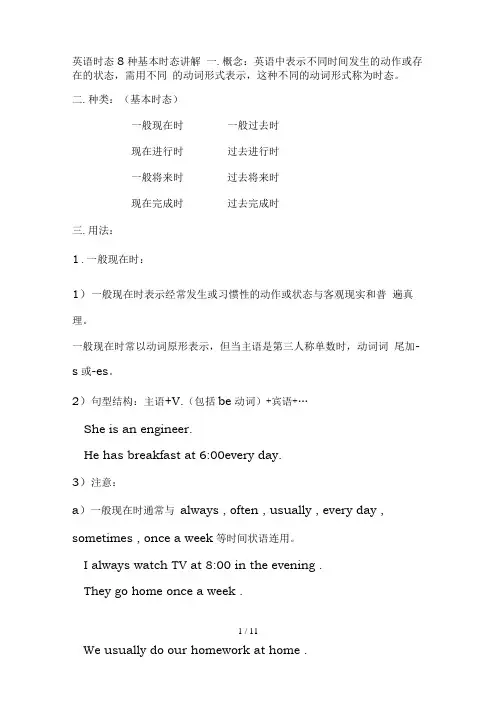
英语时态8种基本时态讲解一.概念:英语中表示不同时间发生的动作或存在的状态,需用不同的动词形式表示,这种不同的动词形式称为时态。
二.种类:(基本时态)一般现在时一般过去时现在进行时过去进行时一般将来时过去将来时现在完成时过去完成时三.用法:1.一般现在时:1)一般现在时表示经常发生或习惯性的动作或状态与客观现实和普遍真理。
一般现在时常以动词原形表示,但当主语是第三人称单数时,动词词尾加-s或-es。
2)句型结构:主语+V.(包括be动词)+宾语+…She is an engineer.He has breakfast at 6:00every day.3)注意:a)一般现在时通常与always , often , usually , every day , sometimes , once a week等时间状语连用。
I always watch TV at 8:00 in the evening .They go home once a week .1 / 11We usually do our homework at home .b)表客观现实或普遍真理。
The sun always rises in the east .The light travels faster than the sound .c)表永远性的动作或状态。
He lives in the country .4)第三人称单数变化形式。
a)一般情况动词在词尾加-s .e---es speak---speaks work-works live---lives b)以o, s, x, ch, sh结尾的单词在词后加-es.do---does go---goes finish---finishes brush---bru shesfix---fixes pass---passes watch---watchesc)以“辅音字母+y”结尾的单词变y为i加-es.Study-studies carry-carries cry---criesd)以“元音字母+y”结尾的单词直接加-s.play---plays stay---stays例句:我们每天晚上九点做作业。
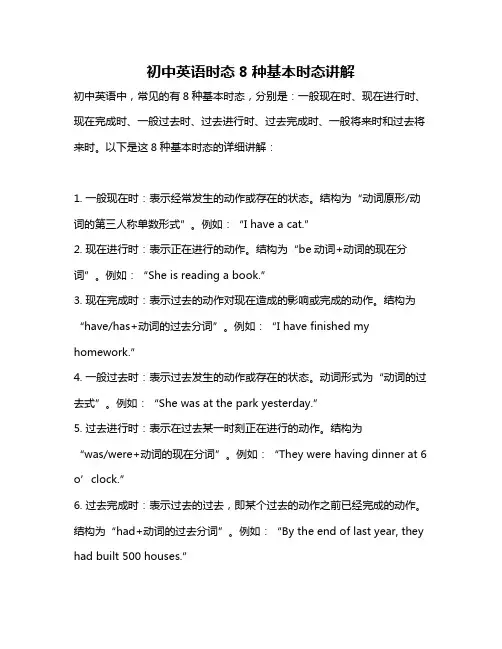
初中英语时态8种基本时态讲解初中英语中,常见的有8种基本时态,分别是:一般现在时、现在进行时、现在完成时、一般过去时、过去进行时、过去完成时、一般将来时和过去将来时。
以下是这8种基本时态的详细讲解:1. 一般现在时:表示经常发生的动作或存在的状态。
结构为“动词原形/动词的第三人称单数形式”。
例如:“I have a cat.”2. 现在进行时:表示正在进行的动作。
结构为“be动词+动词的现在分词”。
例如:“She is reading a book.”3. 现在完成时:表示过去的动作对现在造成的影响或完成的动作。
结构为“have/has+动词的过去分词”。
例如:“I have finished my homework.”4. 一般过去时:表示过去发生的动作或存在的状态。
动词形式为“动词的过去式”。
例如:“She was at the park yesterday.”5. 过去进行时:表示在过去某一时刻正在进行的动作。
结构为“was/were+动词的现在分词”。
例如:“They were having dinner at 6 o’clock.”6. 过去完成时:表示过去的过去,即某个过去的动作之前已经完成的动作。
结构为“had+动词的过去分词”。
例如:“By the end of last year, they had built 500 houses.”7. 一般将来时:表示将来要发生的动作或存在的状态。
结构为“will+动词原形”或“am/is/are going to+动词原形”。
例如:“We will visit the museum next week.”8. 过去将来时:表示从过去的某一时刻看,将来要发生的动作或存在的状态。
结构为“would+动词原形”或“was/were going to+动词原形”。
例如:“He said he would come back soon.”以上就是初中英语8种基本时态的讲解,希望对你有帮助!。
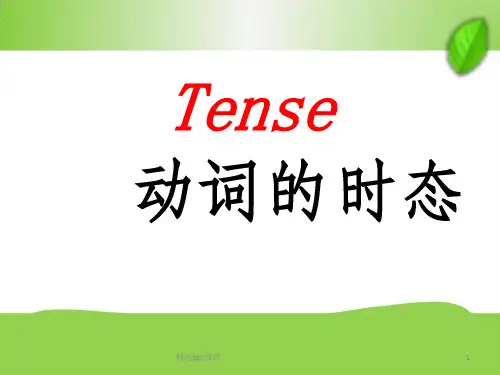
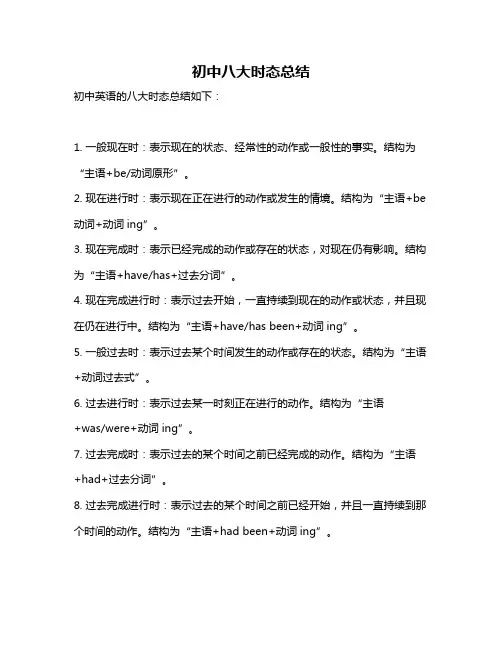
初中八大时态总结
初中英语的八大时态总结如下:
1. 一般现在时:表示现在的状态、经常性的动作或一般性的事实。
结构为“主语+be/动词原形”。
2. 现在进行时:表示现在正在进行的动作或发生的情境。
结构为“主语+be 动词+动词ing”。
3. 现在完成时:表示已经完成的动作或存在的状态,对现在仍有影响。
结构为“主语+have/has+过去分词”。
4. 现在完成进行时:表示过去开始,一直持续到现在的动作或状态,并且现在仍在进行中。
结构为“主语+have/has been+动词ing”。
5. 一般过去时:表示过去某个时间发生的动作或存在的状态。
结构为“主语+动词过去式”。
6. 过去进行时:表示过去某一时刻正在进行的动作。
结构为“主语
+was/were+动词ing”。
7. 过去完成时:表示过去的某个时间之前已经完成的动作。
结构为“主语+had+过去分词”。
8. 过去完成进行时:表示过去的某个时间之前已经开始,并且一直持续到那个时间的动作。
结构为“主语+had been+动词ing”。
以上是初中英语八大时态的总结,希望对你有所帮助。
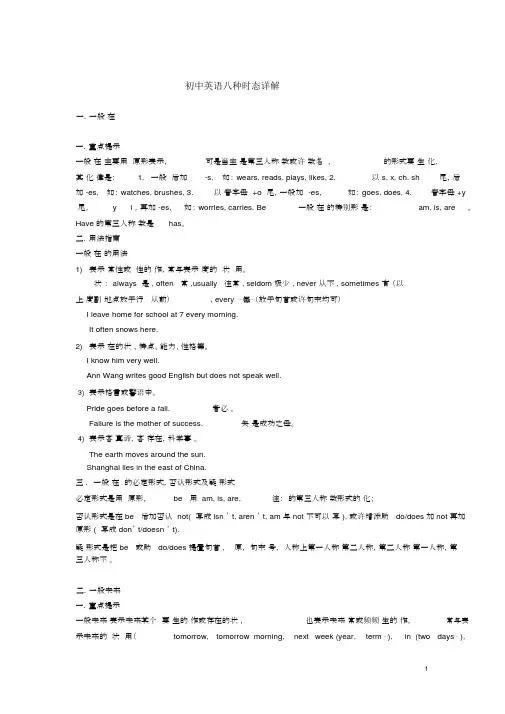
初中英语八种时态详解一.一般在一.重点提示一般在主要用原形表示,可是当主是第三人称数或许数名,的形式要生化,其化律是: 1.一般后加-s,如:wears, reads, plays, likes, 2.以s, x, ch, sh尾,后加 -es,如:watches, brushes, 3.以音字母+o尾,一般加-es,如:goes, does, 4.音字母+y 尾,y i ,再加 -es,如:worries, carries. Be一般在的特别形是:am, is, are。
Have 的第三人称数是has。
二.用法指南一般在的用法1)表示常性或性的作,常与表示度的状用。
状: always 是 , often 常 ,usually 往常 , seldom 极少 , never 从不 , sometimes 有(以上度副地点放于行从前), every ⋯每⋯(放于句首或许句末均可)I leave home for school at 7 every morning.It often snows here.2)表示在的状、特点、能力、性格等。
I know him very well.Ann Wang writes good English but does not speak well.3)表示格言或警语中。
Pride goes before a fall.者必。
Failure is the mother of success.失是成功之母。
4)表示客真谛,客存在,科学事。
The earth moves around the sun.Shanghai lies in the east of China.三 .一般在的必定形式,否认形式及疑形式必定形式是用原形,be 用 am, is, are,注:的第三人称数形式的化;否认形式是在 be 后加否认 not( 写成 isn ’ t, aren ’ t, am 与 not 不可以写 ), 或许增添助 do/does 加 not 再加原形 ( 写成 don’ t/doesn ’ t).疑形式是把 be 或助 do/does 提置句首 , 原,句末号,人称上第一人称第二人称,第二人称第一人称,第三人称不。
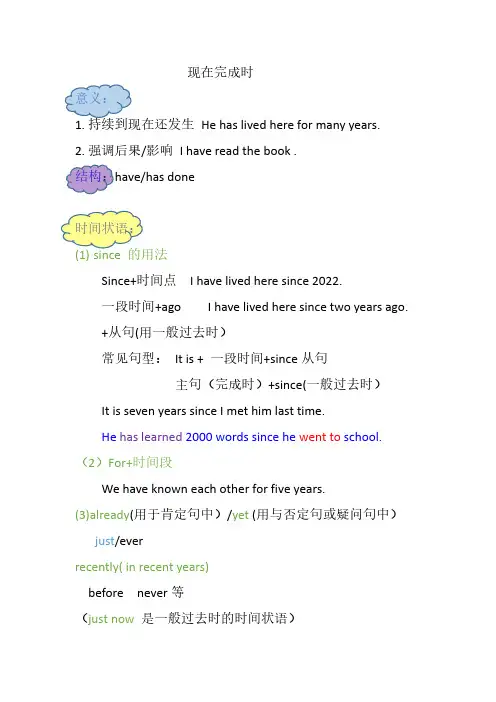
现在完成时意义:He has lived here for many years.2.强调后果/影响I have read the book .结构:时间状语:(1)since 的用法Since+时间点I have lived here since 2022.一段时间+ago I have lived here since two years ago.+从句(用一般过去时)常见句型:It is + 一段时间+since从句主句(完成时)+since(一般过去时)It is seven years since I met him last time.He has learned 2000 words since he went to school.(2)For+时间段We have known each other for five years.(3)already(用于肯定句中)/yet (用与否定句或疑问句中)just/everrecently( in recent years)before never等(just now是一般过去时的时间状语)I have just finished my homework.Have you ever seen one like this?(4So far /in the past few years等,表示:“目前为止”非延续性动词延续性动词非延续性动词延续性动词Borrow Keep Fall asleep Be asleep buy have Catch a cold Have a cold leave Be away Begin/start Be ondie Be dead open Be open Come (to)Be in/at close Be closed区分Have gone to去了没回Have been to去了回来(常与次数once/twice/基数词+times连用)Have been in在某地呆了多久例句:(1)You can’t see her because he has gone to Sibo.(2)He has been to Sibo twice.(3)He has been in this city for two years.备注:Here/there/home 不与介词连用。
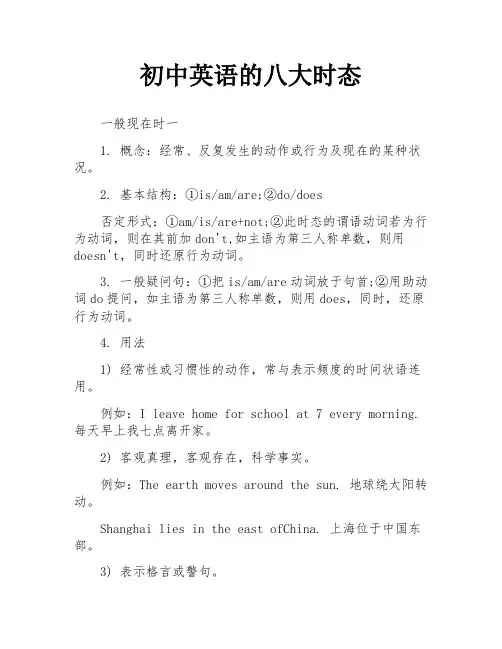
初中英语的八大时态一般现在时一1. 概念:经常、反复发生的动作或行为及现在的某种状况。
2. 基本结构:①is/am/are;②do/does否定形式:①am/is/are+not;②此时态的谓语动词若为行为动词,则在其前加don't,如主语为第三人称单数,则用doesn't,同时还原行为动词。
3. 一般疑问句:①把is/am/are动词放于句首;②用助动词do提问,如主语为第三人称单数,则用does,同时,还原行为动词。
4. 用法1) 经常性或习惯性的动作,常与表示频度的时间状语连用。
例如:I leave home for school at 7 every morning. 每天早上我七点离开家。
2) 客观真理,客观存在,科学事实。
例如:The earth moves around the sun. 地球绕太阳转动。
Shanghai lies in the east ofChina. 上海位于中国东部。
3) 表示格言或警句。
例如:Pride goes before a fall. 骄者必败。
注意:此用法如果出现在宾语从句中,即使主句是过去时,从句谓语也要用一般现在时。
例如:Columbus proved that the earth is round. 哥伦布证实了地球是圆的。
4) 现在时刻的状态、能力、性格、个性。
例如:I don't want so much. 我不要那么多。
Ann writes good English but does not speak well.安英语写得不错,讲的可不行。
5) 一般现在时表示将来含义a. 下列动词e, go, arrive, leave, start, begin, return的一般现在时可以表示将来,主要用来表示在时间上已确定或安排好的事情。
例如:The train leaves at six tomorrow morning. 火车明天上午六点开。
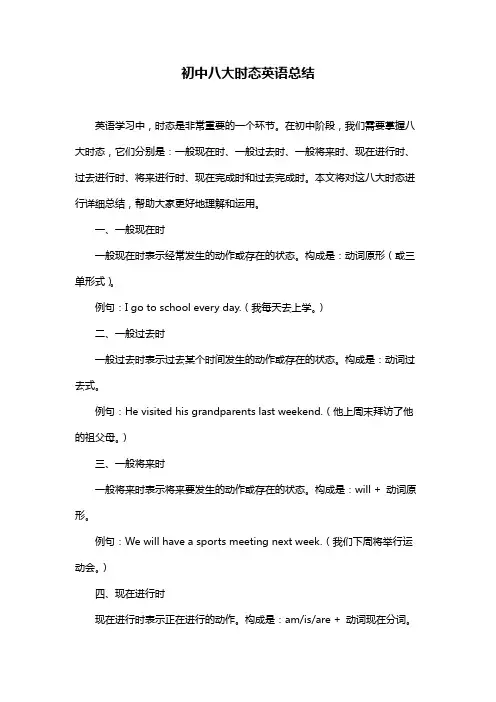
初中八大时态英语总结英语学习中,时态是非常重要的一个环节。
在初中阶段,我们需要掌握八大时态,它们分别是:一般现在时、一般过去时、一般将来时、现在进行时、过去进行时、将来进行时、现在完成时和过去完成时。
本文将对这八大时态进行详细总结,帮助大家更好地理解和运用。
一、一般现在时一般现在时表示经常发生的动作或存在的状态。
构成是:动词原形(或三单形式)。
例句:I go to school every day.(我每天去上学。
)二、一般过去时一般过去时表示过去某个时间发生的动作或存在的状态。
构成是:动词过去式。
例句:He visited his grandparents last weekend.(他上周末拜访了他的祖父母。
)三、一般将来时一般将来时表示将来要发生的动作或存在的状态。
构成是:will + 动词原形。
例句:We will have a sports meeting next week.(我们下周将举行运动会。
)四、现在进行时现在进行时表示正在进行的动作。
构成是:am/is/are + 动词现在分词。
例句:She is watching TV now.(她现在正在看电视。
)五、过去进行时过去进行时表示过去某个时间正在进行的动作。
构成是:was/were + 动词现在分词。
例句:They were playing football at 4 p.m.yesterday.(昨天下午4点他们正在踢足球。
)六、将来进行时将来进行时表示将来某个时间正在进行的动作。
构成是:will be + 动词现在分词。
例句:We will be having a meeting at that time tomorrow.(明天那个时候我们将在开会。
)七、现在完成时现在完成时表示过去发生的动作对现在造成的影响或结果。
构成是:have/has + 动词过去分词。
例句:I have finished my homework.(我已经完成了我的家庭作业。
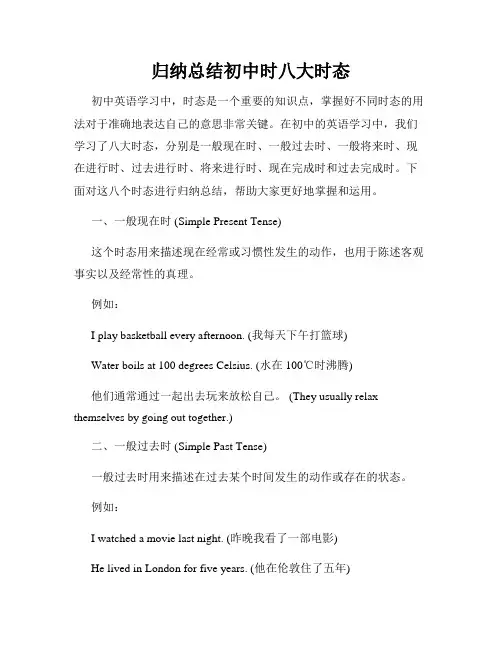
归纳总结初中时八大时态初中英语学习中,时态是一个重要的知识点,掌握好不同时态的用法对于准确地表达自己的意思非常关键。
在初中的英语学习中,我们学习了八大时态,分别是一般现在时、一般过去时、一般将来时、现在进行时、过去进行时、将来进行时、现在完成时和过去完成时。
下面对这八个时态进行归纳总结,帮助大家更好地掌握和运用。
一、一般现在时 (Simple Present Tense)这个时态用来描述现在经常或习惯性发生的动作,也用于陈述客观事实以及经常性的真理。
例如:I play basketball every afternoon. (我每天下午打篮球)Water boils at 100 degrees Celsius. (水在100℃时沸腾)他们通常通过一起出去玩来放松自己。
(They usually relax themselves by going out together.)二、一般过去时 (Simple Past Tense)一般过去时用来描述在过去某个时间发生的动作或存在的状态。
例如:I watched a movie last night. (昨晚我看了一部电影)He lived in London for five years. (他在伦敦住了五年)我们在学校门口等了你很长时间。
(We waited for you for a long time at the school gate.)三、一般将来时 (Simple Future Tense)一般将来时用来表示将来会发生的动作或存在的状态。
例如:I will go shopping tomorrow. (我明天会去购物)She is going to visit her grandparents next month. (她下个月要去看望她的祖父母)我们将在周末举办一场聚会。
(We will have a party this weekend.)四、现在进行时 (Present Continuous Tense)现在进行时用来表示现在正在进行的动作或事情。
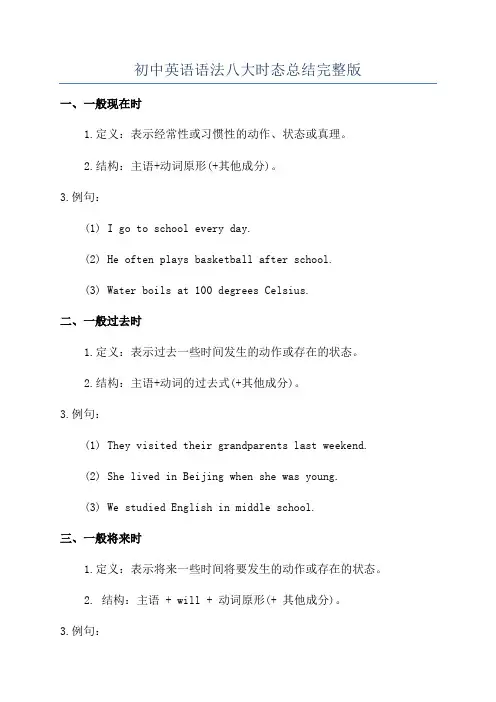
初中英语语法八大时态总结完整版一、一般现在时1.定义:表示经常性或习惯性的动作、状态或真理。
2.结构:主语+动词原形(+其他成分)。
3.例句:(1) I go to school every day.(2) He often plays basketball after school.(3) Water boils at 100 degrees Celsius.二、一般过去时1.定义:表示过去一些时间发生的动作或存在的状态。
2.结构:主语+动词的过去式(+其他成分)。
3.例句:(1) They visited their grandparents last weekend.(2) She lived in Beijing when she was young.(3) We studied English in middle school.三、一般将来时1.定义:表示将来一些时间将要发生的动作或存在的状态。
2. 结构:主语 + will + 动词原形(+ 其他成分)。
3.例句:(1) I will go to the park tomorrow.(3) We will have a party next week.四、现在进行时1.定义:表示现在正在进行的动作。
2. 结构:主语 + am/is/are + 动词-ing(+ 其他成分)。
3.例句:(1) She is reading a book right now.(2) They are playing soccer in the park.(3) We are having dinner at the moment.五、过去进行时1.定义:表示过去一些时间正在进行的动作。
2. 结构:主语 + was/were + 动词-ing(+ 其他成分)。
3.例句:(1) He was watching TV at 8 o'clock last night.(2) They were traveling in Europe during summer vacation.(3) We were studying when the phone rang.六、将来进行时1.定义:表示将来一些时间正在进行的动作。
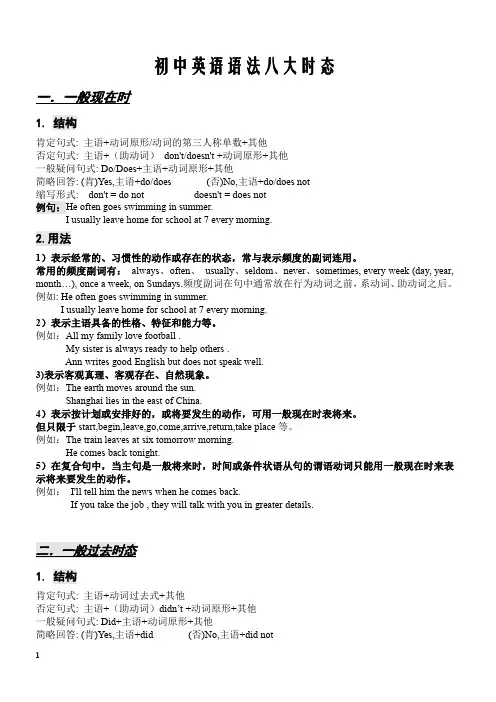
初中英语语法八大时态一.一般现在时1.结构肯定句式:主语+动词原形/动词的第三人称单数+其他否定句式:主语+(助动词)don't/doesn't+动词原形+其他一般疑问句式:Do/Does+主语+动词原形+其他简略回答:(肯)Yes,主语+do/does(否)No,主语+do/does not缩写形式:don't=do not doesn't=does not例句:He often goes swimming in summer.I usually leave home for school at7every morning.2.用法1)表示经常的、习惯性的动作或存在的状态,常与表示频度的副词连用。
常用的频度副词有:always、often、usually、seldom、never、sometimes,every week(day,year, month…),once a week,on Sundays.频度副词在句中通常放在行为动词之前,系动词、助动词之后。
例如:He often goes swimming in summer.I usually leave home for school at7every morning.2)表示主语具备的性格、特征和能力等。
例如:All my family love football.My sister is always ready to help others.Ann writes good English but does not speak well.3)表示客观真理、客观存在、自然现象。
例如:The earth moves around the sun.Shanghai lies in the east of China.4)表示按计划或安排好的,或将要发生的动作,可用一般现在时表将来。
但只限于start,begin,leave,go,come,arrive,return,take place等。
一.八大时态的基本用法1. 一般现在时和一般过去时时间点:现在(一般现在时)过去(一般过去时)表达含义:现在经常发生或者反复发生的动作(一般现在时)过去经常发生或者反复发生的动作(一般过去时)构成:动词原形(第三人称动词后加-s/-es)时间轴表示:2. 现在进行时和过去进行时时间点:此刻(现在进行时)过去某时刻正在进行(过去进行时)表达含义:此刻说话时正在进行的动作(现在进行时)过去某一时刻正在进行的动作(过去进行时)构成:be(am/is/are/were/was+现在分词)时间轴表示:3. 一般将来时和过去将来时时间点:从现在看将来某一个刻(一般将来时)从过去看将来某一刻(过去将来时)表达含义:将来某一个时间点将要发生的动作(一般将来时)从过去看将来某一个时间点将要发生的动作(过去将来时)构成:will/would+动词原形时间轴表示:4. 现在完成时和过去完成时时间点:时间截止到目前为止动作已经完成(现在完成时)时间截止到过去某一刻动作已经完成(过去完成时)表达含义:强调不久前发生的动作对现在产生的影响(现在完成时)表示一个动作在过去某一个时间或动作之前已经完成(过去完成时)构成:have/has/had+动词过去分词时间轴表示:二、八大时态的特殊用法1.一般现在时的特殊用法①在时间或者条件状语从句中一般现在时可以表示将来。
I will discuss this with you when we meet next time. 下次见面时咱们再讨论。
②在表示按时间表拟定的或者安排好的就要发生的事情或者动作时,用一般现在时表示将来。
The train arrives at 9. There’s plenty of time. 火车九点到达,还有充足的时间。
2. 现在进行时的特殊用法①有时,现在进行时可以表示按照计划安排将要发生的动作,特别是使用位置转移的动词,如go, come .leave, arrive, start等。
英语八大时态:一、一般现在时1.表示经常性或习惯性动作,常与表频度的时间状语连用:She often speaks English.I leave home for school at 7 every morning.造句练习:孩子们通常不喜欢家庭作业。
2.表示现在的状态、特征、职业、能力、感觉等:He seems to feel a bit down today.He works as a driver.造句练习:她英语说得好。
3.表示真理、客观存在、科学事实或用于格言警句中:Shanghai lies in the east of China.Columbus proved that the earth is round.Where there is a will, there is a way.造句练习:地球绕太阳转动。
4.表示现在瞬间的动作:Here comes the bus!5.表示将来1)表按规定、计划、安排将要发生的动作(仅限于某些表示“来、去、动、停、开始、结束、继续”等的趋向动词),可以与表示未来的时间状语搭配使用。
常见的用法是:飞机、火车、轮船、汽车等定期定点运行的交通状况。
如:The next train leaves at 3 o’clock this afternoon.How often does the shuttle bus run?2)在时间和条件状语从句中常使用一般现在时表示将来发生的事情:When Bill comes (不用will come), ask him to wait for me.I shall go there tomorrow unless I’m too busy.【练习题】①Nowadays, a large number of women, especially those who from the countryside, ___ in theclothing industry.A.is workingB.worksC.workD.worked②–What would you do if it ___ tomorrow?--We have to carry it on, since we’ve got everything already.A. rainB. rainsC. will rainD. is raining二、一般过去时标志:动词过去式1.表示过去某时所发生的动作或存在的状态,常与表示过去的时间状语连用(e.g. yesterday,this morning, just now, a moment ago, in May, last night / year / week, once upon a time, the other day, before …, when …, in the past等)。
初中英语必考八大时态结构及用法详解初中英语八大时态的结构及用法如下:1. 现在一般时态:基本结构为动词的原型(第三人称单数时动词后面+s, es)。
表示“现在发生的动作、情况、状态和特征”。
常与now,today,this week等时间状语连用。
2. 过去一般时态:基本结构为动词的过去式(动词的过去式在规则动词中直接在原形词尾加-d或-ed,在词尾是e的直接加d,以“辅音字母+y”结尾的动词,先将y改为i,再加-ed)。
表示“过去发生的动作或存在的状态”。
常与yesterday,last week等时间状语连用。
3. 现在进行时态:基本结构为be(am/is/are)+动词的现在分词(动词后面+ing)。
表示“现在正在进行的动作”。
常与now,at the moment等时间状语连用。
4. 过去进行时态:基本结构为was/were+动词的现在分词(动词后面+ing)。
表示“过去正在进行的动作”。
常与at this time yesterday等时间状语连用。
5. 现在完成时态:基本结构为have/has+过去分词(动词后面+ed)。
表示“过去的动作对现在造成的影响或结果”。
常与already,yet,so far等副词连用。
6. 过去完成时态:基本结构为had+过去分词(动词后面+ed)。
表示“过去的动作在过去的某个时间之前已经完成或发生的动作或存在的状态”。
常与by the end of last year,by the time of等时间状语连用。
7. 现在完成进行时态:基本结构为have/has been+动词的现在分词(动词后面+ing)。
表示“动作从过去某时开始,一直延续到现在,或者刚刚完成”。
常与for several days,since等时间状语连用。
8. 过去完成进行时态:基本结构为had been+动词的现在分词(动词后面+ing)。
表示“过去的某个动作从过去某时开始,一直延续到过去的某个时间,或者刚刚完成”。
初中英语语法八大时态总结一、一般现在时态(Simple Present)1.表示现在经常性、习惯性的动作或状态:- Lucy goes to school by bus every day.- They often play basketball in the park.2.表示客观事实或普遍真理:- The sun rises in the east.- Water boils at 100 degrees Celsius.3.表示评论、观点等:- I think it's a good idea.- He doesn't like swimming.二、一般过去时态(Simple Past)1.表示过去一些时间发生的动作或状态:- They visited their grandparents last weekend.- I lived in London for two years.2.表示过去的经常性动作或状态:- We often played soccer after school.- She worked in a restaurant when she was a student.3.表示与现在相反的情况或假设:- If I had money, I would buy a new car.- I wish I could go to the concert with you.三、一般将来时态(Simple Future)1.表示将来要发生的事情:- I will meet him at the airport tomorrow.- They are going to have a party next week.2.表示意愿、打算或承诺:- I promise I will help you.- She is going to study abroad next year.四、现在进行时态(Present Continuous)1.表示现在正在进行或暂时的动作:- They are playing football in the park.- He is studying for the exam.2.表示现阶段的变化或趋势:- The population of the city is increasing rapidly.- More and more people are using smartphones.五、过去进行时态(Past Continuous)1.表示过去一些时间正在进行中的动作:- I was watching TV when she called me.- They were having dinner when the power went out.2.表示过去一些时间同时发生的两个动作:- While he was reading, his sister was playing the piano.- When I arrived, they were still waiting for you.六、将来进行时态(Future Continuous)1.表示将来一些时间正在进行的动作:- He will be sleeping when you arrive.2.表示将来一些时间同时发生的两个动作:- While you are washing the dishes, I will be cleaning the bathroom.- When I call you, she will be cooking dinner.七、现在完成时态(Present Perfect)1.表示过去发生但对现在有影响的动作或状态:- I have lost my key, so I can't open the door.- She has finished her homework, so she can watch TV now.2.表示经历或遭遇过的事情:- Have you ever been to Paris?- He has never seen such a beautiful sunset.八、过去完成时态(Past Perfect)1.表示在过去一些时间之前已经发生的动作或状态:- When I arrived, they had already left.2.表示过去一些时间之前一直存在或保持的状态:- He had lived in that house for 10 years before he moved out.- She had been planning the party for weeks.。
初中英语基本时态总结Ⅰ、一般现在时1、概念:1)表示经常性或习惯性的动作,常与表示频度的时间状语连用。
时间状语:always, usually, often, sometimes, seldom, never, every day, twice a week, on Sunday, etc.(提问用How often)例:I leave home for school at 7 every morning.Tom gets up at 6:00 every morning.2)客观真理,客观存在,科学事实。
例:The earth moves around the sun. 地球绕太阳转动。
Shanghai lies in the east of China. 上海位于中国东部。
3)格言或警句。
例:Pride goes before a fall. 骄者必败。
注意:宾语从句中,即使主句是过去时,从句谓语是客观真理也要用一般现在时。
例:Columbus proved that the earth is round. 哥伦布证实了地球是圆的。
2、结构:表状态S+ am/is/are+ P (句中有实义动词不用be)表动作S+V原+O (若主语是单三人称,谓动加s/es。
)3、句式变化:变疑问,有be把be提到主语前;无be在主语前加do/does,谓动变为原形。
变否定,有be在be后加“not”;无be在主语后加don’t/doesn’t,谓动变为原形。
例:①They are in the classroom. →Are they in the classroom? Yes, they are./No, they aren’t. →They aren’t in the classroom②He often waters the flowers . → Does he often water the flowers?Yes, he does. / No, he doesn’t. →He doesn’t often water the flowersⅡ、一般过去时1、概念:1)表示在确定的过去时间里所发生的动作或存在的状态。
初中英语必考八大时态结构及用法详解一、一般现在时1. 概念:经常、反复发生的动作或行为及现在的某种状况。
2. 基本结构:①is/am/are;②do/does否定形式:①am/is/are+not;②此时态的谓语动词若为行为动词,则在其前加don't,如主语为第三人称单数,则用doesn't,同时还原行为动词。
3. 一般疑问句:①把is/am/are动词放于句首;②用助动词do提问,如主语为第三人称单数,则用does,同时,还原行为动词。
4. 用法1) 经常性或习惯性的动作,常与表示频度的时间状语连用。
例如:I leave home for school at 7 every morning. 每天早上我七点离开家。
2) 客观真理,客观存在,科学事实。
例如:The earth moves around the sun. 地球绕太阳转动。
Shanghai lies in the east ofChina. 上海位于中国东部。
3) 表示格言或警句。
例如:Pride goes before a fall. 骄者必败。
注意:此用法如果出现在宾语从句中,即使主句是过去时,从句谓语也要用一般现在时。
例如:Columbus proved that the earth is round. 哥伦布证实了地球是圆的。
4) 现在时刻的状态、能力、性格、个性。
例如:I don't want so much. 我不要那么多。
Ann writes good English but does not speak well.安英语写得不错,讲的可不行。
5) 一般现在时表示将来含义a. 下列动词come, go, arrive, leave, start, begin,return的一般现在时可以表示将来,主要用来表示在时间上已确定或安排好的事情。
例如:The train leaves at six tomorrow morning. 火车明天上午六点开。
人教版初中英语八大时态详解
英语的时态( tense )是一种动词形式,不同的时态用以表示不同的时间与方式。
下面就英语中常见的八种基本时态进行阐述,其它的时态都是在这八种时态的基础上结合而成的。
一、一般现在时:
1. 概念:经常、反复发生的动作或行为及现在的某种状况。
2. 时间状语:always, usually, often, sometimes, every week (day, year, month...), once a week, on Sundays,
3. 基本结构:动词原形 (如主语为第三人称单数,动词上要加( e)S)
4. 否定形式:am/is/are+not;此时态的谓语动词若为行为动词,则在其前加don7t,如
主语为第三人称单数,则用doesn / t,通常还原行为动词。
5. 一般疑问句:把be 动词放于句首;用助动词do 提问,如主语为第三人称单数,则用does,同时,还原行为动词。
6. 例句:It seldom snows here.
He is always ready to help others.
Action speaks louder than words.
二、一般过去时:
1. 概念:过去某个时间里发生的动作或状态;过去习惯性、经常性的动作、行为。
2. 时间状语:ago, yesterday, the day before yesterday, last week(year, night, mon
th …),in 1989, just now, at the age of 5, one day, long long ago, once upon a time, etc.
3. 基本结构:be 动词;行为动词
4. 否定形式:was/were+not;在行为动词前加didn' t,同时还原行为动词。
5 .一般疑问句:was 或were 放于句首;用助动词do 的过去式did 提问,同时还原行为动词。
6. 例句:She often came to help us in those days.
I didn 't know you were so busy.
三、现在进行时:
1. 概念:表示现阶段或说话时正在进行的动作及行为。
2. 时间状语:now, at this time, these days, etc.
3. 基本结构:am/is/are+doing
4. 否定形式:am/is/are+not+doing.
5. 一般疑问句:把be 动词放于句首。
6. 例句:How are you feeling today?
He is doing well in his lessons.
四、过去进行时:
1. 概念:表示过去某段时间或某一时刻正在发生或进行的行为或动作。
2. 时间状语:at this time yesterday, at that time 或以when 引导的谓语动词是一般过去时的时间状语等。
3. 基本结构:was/were+doing
4. 否定形式:was/were + not + doing.
5. 一般疑问句:把was 或were 放于句首。
6. 例句:At that time she was working in a PLA unit. When he came in, I was
reading a newspaper.
五、现在完成时:
1. 概念:过去发生或已经完成的动作对现在造成的影响或结果,或从过去已经开始,持续到现在的动作或状态。
2. 时间状语:recently, I ately, since …for …,in the past few years, etc.
3. 基本结构:have/has + done
4. 否定形式:have/has + not +done.
5. 一般疑问句:have 或has 提前
6. 例句:I've written an article.
It has been raining these days.
六、过去完成时:
1. 概念:以过去某个时间为标准,在此以前发生的动作或行为,或在过去某动作之前完成的行为,即“过去的过去”。
2. 时间状语:before, by the end of last year(term, month … ),etc.
3. 基本结构:had + done.
4. 否定形式:had + not + done.
5. 一般疑问句:had 放于句首。
6. 例句:As soon as we got to the station, the train had left.
By the end of last month. We had reviewed four books
七、一般将来时:
1. 概念:表示将要发生的动作或存在的状态及打算、计划或准备做某事。
2. 时间状语:tomorrow, next day(week, month, year … ),soon, in a few minutes, by …,the day after tomorrow, etc.
3. 基本结构:am/is/are/going to + do ;will/shall + do.
4. 否定形式:was/were + not;在行为动词前加won 7t,同时还原行为动词。
5. 一般疑问句:be 放于句首;will/shall 提到句首。
6. 例句:They are going to have a competition with us in studies.
It is going to rain.
八、过去将来时:
1. 概念:立足于过去某一时刻,从过去看将来,常用于宾语从句中。
2. 时间状语:the next day(morning, year … ),the following month(week … ),etc.
3. 基本结构:was/were/going to do ;would/should + do.
4. 否定形式:was/were/not + going to + do;would/should + not + do.
5. 一般疑问句:was 或were 放于句首;would/should 提到句首。
6. 例句:He said he would go to Beijing the next day. I asked who was going
there .
1. 一般现在时:主语+do/does(现在分词)
e.g We clea n the room every day.
2. 一般过去时:主语+did
e.g We clea ned the room just now.
3. 现在进行时:主语+am/is/are doing
e.g We are clea ning the room now.
4. 过去进行时:was/were doing
e.g We were chea ning the room at 5:00 yesterday after noon.
5. 现在完成时:have/has done
e.g.We have clea ned the room already.
6. 过去完成时:had done
e.g We had clea ned the room before he arrived.
7. 一般将来时:will do/
e.g We will clea n the room tomorrow.
8. 过去将来时:was/were to /would do
e.g He said he would clea n the room n ext.。